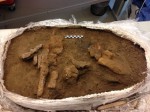Excavations of the 10th century Borgring fortress discovered on the Danish island of Zealand in 2014 are still in the early stages. A few test pits were dug in 2014 in areas believed to be, based on initial laser and geomagnetic surveys of the site, the fortress gates. Large oak timbers, blackened by fire, confirmed that there had indeed been gates there and that the fort had had a catastrophic fire shortly after its construction. Few artifacts were found. Only a single axe head was reported, that I could find.
 That record has changed dramatically thanks to the discovery of a rare Viking toolkit at the east gate. Volunteer metal detectorists Kent and Knuds scanned the area and got a loud signal from their machines. Archaeologists could tell there was something in the soil there, and since the signal indicated the metal wasn’t in the top layer (where it could easily have been a piece of modern farm equipment) but rather deeper down in the layers of archaeological interest, they decided to remove the whole block of soil encasing whatever had set off the metal detectors.
That record has changed dramatically thanks to the discovery of a rare Viking toolkit at the east gate. Volunteer metal detectorists Kent and Knuds scanned the area and got a loud signal from their machines. Archaeologists could tell there was something in the soil there, and since the signal indicated the metal wasn’t in the top layer (where it could easily have been a piece of modern farm equipment) but rather deeper down in the layers of archaeological interest, they decided to remove the whole block of soil encasing whatever had set off the metal detectors.
 Wrapped in plastic to keep it together, the entire soil block was transported to the Zealand University Hospital in Køge to get a CT scan. The hospital scanner confirmed that there was a group of iron objects inside that looked like they might be tools including spoon drills (used to drill holes in wood) and a drawplate (used to produce thin wire for jewelry). The pieces appeared to be laid out in careful order, suggesting they weren’t dumped or lost. They were likely kept in a toolbox whose wood has now decayed.
Wrapped in plastic to keep it together, the entire soil block was transported to the Zealand University Hospital in Køge to get a CT scan. The hospital scanner confirmed that there was a group of iron objects inside that looked like they might be tools including spoon drills (used to drill holes in wood) and a drawplate (used to produce thin wire for jewelry). The pieces appeared to be laid out in careful order, suggesting they weren’t dumped or lost. They were likely kept in a toolbox whose wood has now decayed.
Archaeologists spent two days excavating the soil block and found 14 iron objects. There were pieces that were not visible on the scan because they were too corroded or their iron content was too low to register. The more corroded objects cannot be identified at this time; conservation may help make it clear what their original purpose was, and now that they’ve been removed from the soil block, the objects will be individually X-rayed to get a better idea of their design. Archaeologist Nanna Holm suspects one of the spoon drills may actually be a pair of tweezers or pliers, for example.
This box of tools would have been extremely valuable in the Viking era. Only a few of them have ever been discovered. If a tool was broken or became unusable for any reason, they were melted down and made into something else practical, not thrown out. The discovery of a fully loaded toolbox by the east gate is highly significant within the context of Borgring itself, because it’s the first evidence that people actually lived there.
The craftsmen presumably lived very well, whether he used the east gate as a home or a workshop. It was 30 to 40 square metres of space and had its own fireplace–and of course, the toolbox with the valuable iron tools.
So why did he leave the premises and his toolbox?
Perhaps because at some point, the gate simply collapsed, says Holm.
“We found the tools under the posts, so there’s some evidence that the gate collapsed, and it probably did so because they were rotten, old, and unstable. We only discovered the outline of the posts, suggesting that the rest simply rotted away. Then the tools got buried until we discovered now,” she says.
It seems that the fire that struck the east and north gates did not destroy the fort. It was put out before the gates could collapse and the fire spread to the rest of the fortress. After the fire, two layers of clay were built up inside the gate. There was a fireplace in each layer, and the toolbox was unearthed from the newer of the two clay layers. That means the craftsman who lived or worked at the east gate did so after the fire.
The tools are being studied and conserved now. Next year, conservation should be complete and the toolkit will go on public display.
Timelapse of the excavation of the toolbox:
[youtube=https://youtu.be/Js0nlQa723s&w=430]
A journalist joins in the excavation:
[youtube=https://youtu.be/Dz5kpA0SRe4&w=430]

I understand that the general rule for the Dark Ages, at least in Britain, is that apart from pagan grave goods and the occasional hoard of treasure, finds are usually pitifully sparse.